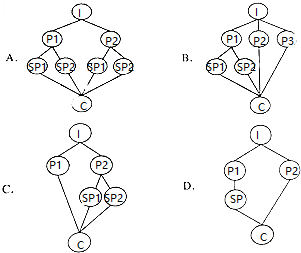题目内容
1.El Nifio,a Spanish term for"the Christ child",was named by South American fisherman who noticed that the global weather pattern,which happens every two to seven years,reduced the amount of fishes caught around Christmas.El Nifio sees warm water,collected over several years in the western Pacific,flow back eastwards when winds that normally blow westwards weaken,or sometimes the other way round.The weather effects both good and bad,are felt in many places.Rich countries gain more from powerful Nifio,on balance,than they lose.A study found that a strong Nifio in 1997 helped American's economy grow by 15 billion,partly because of better agricultural harvest,farmers in the Midwest gained from extra rain.The total rise in agricultural in rich countries in growth than the fall in poor ones.
But in Indonesia extremely dry forests are in flames.A multi-year drought (干旱)in south-east Brazil is becoming worse.Though heavy rains brought about by El Nino may relieve the drought in California,they are likely to cause surface flooding and other disasters.
The most recent powerful Nino,in 1997-98,killed around 21,000 people and caused damage worth $36 billion around the globe.But such Ninos come with months of warning,and so much is known about how they happen that governments can prepare.According to the Overseas Development Institute (ODI),however,just 12% of disaster-relief funding in the past two decades has gone on reducing risks in advance,rather than recovery and rebuilding afterwards.This is despite evidence that a dollar spent on risk-reduction saves at least two on reconstruction.
Simple improvements to infrastructure (基础设施)can reduce the spread of disease.Better sewers (下水道)make it less likely that heavy rain is followed by an outbreak of the disease of bad stomach.Stronger bridges mean villages are less likely to be left without food and medicine after floods.According to a paper in 2011 by Mr Hsiang and co-authors,civil conflict is related to El Nino's harmful effects-and the poorer the country,the stronger the link.Though the relationship may not be causal,helping divided communities to prepare for disasters would at least reduce the risk that those disasters are followed by killing and wounding people.Since the poorest are least likely to make up for their losses from disasters linked to El Nino,reducing their losses needs to be the priority.
61.What can we learn about El Nino in Paragraph 1?D
A.It is named after a South American fisherman.
B.It takes place almost every year all over the world.
C.It forces fishermen to stop catching fish around Christmas.
D.It sees the changes of water flow direction in the ocean.
62.What may El Ninos bring about to the countries affected?C
A.Agricultural harvests in rich countries fall.
B.Droughts become more harmful than floods.
C.Rich countries'gains are greater than their losses.
D.Poor countries suffer less from droughts economically.
63.The data provided by ODI in Paragraph 4 suggest thatA
A.more investment should go to risk reduction
B.governments of poor countries need more aid
C.victims of El Nino deserve more compensation
D.recovery and reconstruction should come first
64.What is the author's purpose in writing the passage?D
A.To introduce El Nino and its origin.
B.To explain the consequences of El Nino.
C.To show ways of fighting against El Nino.
D.To urge people to prepare for El Nino.
分析 本文介绍了厄尔尼诺现象,并讲述了该现象给世界各国带来的影响.虽然富裕国家从厄尔尼诺现象中获得的远比他们失去的多,但它却给一些贫穷的国家带来了灾难,并使他们遭受了极大的损失;因此,呼吁人们要事先为厄尔尼诺做准备,要把减少人们的损失当作首要的任务.
解答 答案:
61.D 细节理解题 根据第一段"El Nifio sees warm water,collected over several years in the western Pacific,…,or sometimes the other way round.当风通常向西,或有时则向相反的方向减弱时,厄尔尼诺就会看到在西太平洋聚集了多年的温水回流到东部"的内容可知,此处表达了它看到了海洋水流方向的变化;故选D
62.C 细节理解题 该题的题干是:厄尔尼诺现象给各个国家可能带来的影响是什么?第二段中的"Rich countries gain more from powerful Nifio,on balance,than they lose总的来说,富裕国家从强大的厄尔尼诺中获得的远比他们失去的多."与C."Rich countries'gains are greater than their losses.富裕国家的收益大于他们的损失."表达的意思相同;故选C
63.A 推理判断题.该题的题干是:第四段中,由ODI提供的数据表明了什么?根据第四段"According to…(ODI),however,just 12% of disaster-relief funding in the past two decades has gone on reducing risks in advance,rather than recovery and rebuilding afterwards.在过去的二十年中,只有12%的救灾资金事先用于减少风险,而不是用于之后的恢复与重建"表达的意思可知,"A.more investment should go to risk reduction 更多的投资应该用于减少风险"符合文中的意思;故选A.
64.D 主旨大意题.该题的题干是:作者的写作意图是什么?根据最后一句"Since the poorest are least likely to make up for their losses from disasters linked to El Nino,reducing their losses needs to be the priority.由于最贫穷的人根本不可能从与厄尔尼诺相关的灾难中弥补他们的损失,因此首要的任务是减少他们的损失",可知"D.To urge people to prepare for El Nino 呼吁人们为厄尔尼诺做准备"正是本文的主旨思想;故选D.
点评 在做阅读理解题时,首先需要快速的浏览全文,把握文章的主旨大意;其次要学会带着问题到文中相应的地方,通过细节阅读来寻找或概括答案;最后理清作者的写作思路也非常重要;总之,做此类题时,需要平时加大阅读量,掌握一些阅读技巧.

 阅读快车系列答案
阅读快车系列答案| A. | should | B. | could | C. | might | D. | would |
---I ,either,if my teacher hadn't reminded me of it.( )
| A. | didn't | B. | hadn't | C. | wouldn't | D. | wouldn't have |
| A. | phoned | B. | phone | C. | will phone | D. | have phoned |
| A. | found | B. | founding | C. | founded | D. | to be founded |
| A. | account for | B. | answer for | C. | compensate for | D. | allow for |
-Yes,that's why I ____ to work by train.( )
| A. | have been going | B. | have gone | C. | was going | D. | will have gone |
